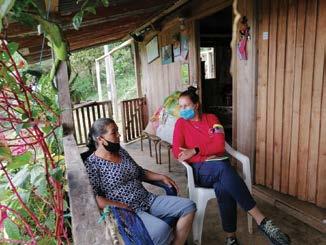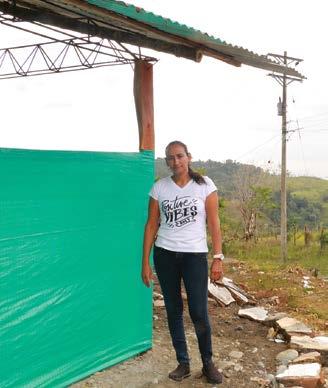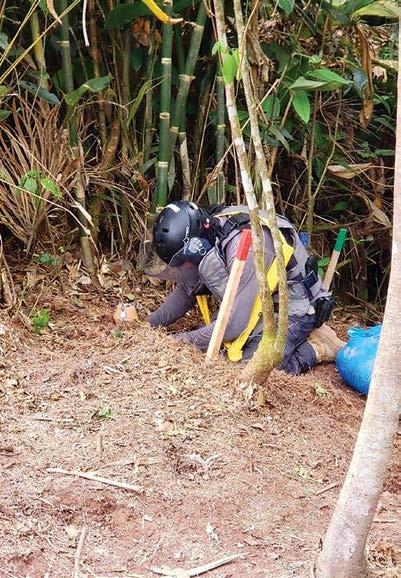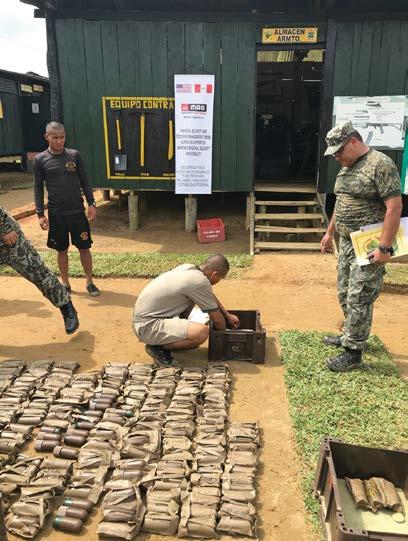
10 minute read
WESTERN HEMISPHERE
TOTAL U.S. CONVENTIONAL WEAPONS DESTRUCTION FUNDING IN THE WESTERN HEMISPHERE FROM ALL U.S. AGENCIES, 1993–2020: MORE THAN $225 MILLION
The United States’ CWD programs in Latin America seek to strengthen civilian protection and advance U.S. national security objectives, including safeguarding the integrity of the U.S. southern border. CWD assistance strengthens foreign munitions depot management and security, curbs the pilferage and illicit trafficking of SA/LW, and reduces the risk of catastrophic explosions at munitions storage sites. In addition, CWD assistance makes it more difficult for drug traffickers, criminal gangs, and terrorists to obtain weapons from poorly-secured stockpiles. The United States currently supports such PSSM initiatives in Ecuador, El Salvador, Guatemala, Honduras, and Peru.
Advertisement
Beyond illicit weapons proliferation, landmines and ERW threaten civilians in the aftermath of conflicts, in some cases for decades after fighting has ended. The 2016 peace accord between the Colombian government and the Revolutionary Armed Forces of Colombia (the FARC) enabled significant increases in demining operations as previously non-permissive locations became accessible. Colombia remains the most landmine contaminated country in the hemisphere, but support from the United States and other donors, and its significant domestic clearance capacity, continues to facilitate progress in returning large tracts of land to productive use.
WOMEN WORKING TOGETHER IN COLOMBIA
Story and photos courtesy of HALO.
Andrea Garcia (right) talks with a local resident while conducting an NTS in San Juan de Arama, Colombia.
Andrea Garcia and her family were forced to flee to Bogotá as violence between guerrilla groups and paramilitaries surged in her hometown of San Juan de Arama. After living in Bogotá for many years attending high school and college, Andrea returned to San Juan de Arama to restore their home destroyed by conflict. Once settled, Andrea applied to HALO after a family member told her about a recruitment drive. Having first-hand experience of the destruction caused by the conflict, Andrea knew that she would be passionate about working in HMA.
Today, Andrea is one of the NTS assistants financed by the U.S. State Department in the Department of Meta. Support from the United States government allows her to do a job that she loves, while improving her quality of life and that of her community, “Without this support, the community would not have the knowledge to remove the mines, or to know what to do if there is an accident, or even know how to avoid mines. So, I think that’s the most satisfactory thing for us as an organization. With our work we help return land to the people, allowing them to build, harvest, cultivate, raise livestock, and make a life for themselves. For me, that’s spectacular.”
With support from the U.S. Department of State, HALO had previously cleared 5,600 square meters of contaminated land that surrounded the road leading to an elementary school in Lejanías, including ten IEDs from the banks of the road. This allowed schoolteacher Dory Valazquez and her students to walk to class without the fear of an ERW accident. “Before the land beside the road leading to our school was cleared, the parents and I always feared a child would leave the safe path that we showed them. Every day I was afraid we would have an accident with one of the children and the mines. Now the children can come and learn in a safe environment.”
Andrea, Dory, and the ten students ages 5-11, are thankful for all that the U.S. government and HALO have done for them and their region.

Dory Valazquez stands next to the temporary school.
COLOMBIA
More than 50 years of conflict between the government of Colombia, guerilla movements, and other non-state actors resulted in widespread improvised landmine contamination. The Office of the High Commissioner for Peace (OACP) reports that Colombia has suffered more than 11,900 mine incidents since 1990, the highest number of recorded casualties in the Western Hemisphere. Its most heavily affected Departments are Antioquia, Caquetá, Cauca, Meta, Nariño, and Norte de Santander. To confront this threat, the government of Colombia has committed significant resources to returning previously-contaminated land to productive use, including more than 5,200 humanitarian deminers from its military.
From 2001 to 2020, the United States invested more than $159 million to support Colombia’s mine action sector by facilitating the survey of priority municipalities and clearance of high-impact minefields, focusing on areas where such efforts coincide with planned development and stabilization projects. Additionally, the Department of State’s assistance is embedding technical advisors within the OACP to strengthen its capacity and support a country-wide quality management program to ensure land is cleared in accordance with international and national standards.
In 2020, the Department of State supported the following implementing partners:
• Colombian Campaign Against Landmines (CCCM) continued to conduct survey and clearance in Putumayo Department and returned 2,655 square meters of land, directly benefitting 378 people. CCCM also provided EORE to 1,572 community members.
• DDG continued to conduct survey and began clearance in San Jose del Fragua, a municipality within Caquetá Department. In 2020, DDG successfully returned 8,652 square meters (2.1 acres) and provided EORE to 1,331 people.
• FSD continued to strengthen the OACP’s capacity by embedding technical advisors to support operations and share knowledge. FSD also helped update existing national standards and prepare new standards, including a process on land release, which should greatly expedite progress in Colombia.
• GICHD began a new project to conduct a third-party review and assessment of the quality management system in Colombia.
• HALO continued to conduct survey, clearance, and EORE in Antioquia, Cauca, Meta, and Norte de Santander Departments.
HALO cleared 84,557 square meters (20.9 acres) of hazardous land, directly benefitting 338 people. Through manual clearance and EOD callouts, 100 items of explosive ordnance were safely destroyed. HALO delivered 50 EORE sessions, benefitting 1,221 people. HALO also successfully handed over five municipalities across three departments to be landmine free. A post-clearance impact assessment was carried out in two municipalities in Antioquia. The impact assessment further demonstrated the causal link between humanitarian demining activities and socioeconomic development, measured through five key indicators: the return of IDPs; land restitution; socio- economic development; post-clearance land use; and the establishment of development projects.
• HI continued to implement survey and clearance in Cauca and
Meta Departments. HI provided EORE to over 1,136 Colombians.
• OAS continued to implement the country-wide quality management program, including accreditation and quality assurance/quality control of civilian and military humanitarian demining organizations and personnel, and provided technical expertise and advice to the OACP. The OAS also collaborated with the government of Colombia to begin transitioning oversight of the quality management program back to the government. Additionally, the OAS continued to provide equipment and support to the Colombian Marine humanitarian demining teams conducting survey and clearance in Bolívar and Sucre Departments.
• SoS continued to disseminate EORE messages through community and school events in locations where broader security considerations currently preclude clearance, and safely delivered EORE to more than 3,138 men, women, and children living in or near suspected mine and ERW contamination.
With funding from the Department of Defense,
• HD R&D, through a partnership with HALO, continued evaluating the Bearcat vegetation clearance system.
• U.S. Southern Command (SOUTHCOM), in partnership with HD R&D donated a Bearcat and five Rambo 4X4s (Polaris Pro XD 4000D ATVs). In addition, due to COVID-19 travel restrictions SOUTHCOM and HDTC postponed a scheduled Requirements Determination Site Survey (RDSS) visit to assess the Colombian military’s requirements for PSSM and EOD training and equipment.
With funding from USAID, the LWVF supported the International Organization for Migration to strengthen functional rehabilitation services in Colombia. They also supported the Arcangeles Foundation to develop inclusive sport activities and physical rehabilitation services in conflict affected communities. As part of multi-regional programs, the LWVF also supported both R4D and WHO to integrate and strengthen rehabilitation services in existing healthcare systems.

Manual clearance operations are conducted in the heavily contaminated Caquetá Department, Colombia.
Photo courtesy of DDG.
ECUADOR
Ecuador has invested a significant amount of internal resources to store and protect its national weapons stockpiles. Many of the country’s stockpiles hold obsolete weapons from a border conflict with Peru in 1995. The military maintains a capacity to manage its inventory and dispose of obsolete and aging munitions items. The United States is supporting Ecuador to improve maintenance at priority depots, facilitate the destruction of obsolete ordnance, and further align its EOD curriculum with international standards. Following President Moreno’s visit to the White House in February 2020, Ecuador hosted a senior Department of State official to coordinate and plan a new CWD program.

A team in Guatemala prepares UXO for demolition.
Photo courtesy of HALO.
In 2020, the Department of State supported the following implementing partner (with prior year funds): • MAG facilitated the destruction of obsolete ordnance, including over 220,000 rounds of small arms ammunition, and provided ammunition management courses to Ecuador’s armed forces. In the future, this program will enhance priority facilities’ infrastructure with improved physical security upgrades.
With funding from the Department of Defense, SOUTHCOM and HDTC, with the assistance of the Defense Security Cooperation Agency, Embassy Quito’s Security Cooperation Office, and MAG, conducted an RDSS of the Ecuadorian Army 68th Engineering Battalion (“Cotopaxi”), which houses the EOD component of Ecuador’s military engaged in BAC and counter-IED operations, to identify capabilities and shortfalls in landmine clearance and casualty care. The changes recommended by the RDSS, scheduled for implementation in the last quarter of CY 2020, were postponed due to the travel restrictions imposed by the COVID-19 pandemic.
EL SALVADOR, GUATEMALA, HONDURAS
Central America’s porous borders and illegally armed groups facilitate and sustain illicit proliferation of SA/LW that threatens civilians and host nation security forces. Additionally, the significant number of confiscated and stored weapons remain a major proliferation risk as they are often highly vulnerable to theft. Many of the weapons confiscated from criminal organizations are military-grade.
From 2016-2019, the United States invested more than $2.9 million to support CWD in El Salvador, Guatemala, and Honduras. Specifically, CWD projects are designed to better secure vulnerable depots through PSSM enhancements and provide specialized PSSM and EOD training to develop national capacity within the military and national police forces. In coordination with local authorities, confiscated firearms and obsolete ammunition and ordnance were also destroyed.
In 2020, the Department of State consolidated the El Salvador, Guatemala, and Honduras projects into one regional project. Specifically, HALO is destroying obsolete weapons, strengthening the national military and police PSSM capacities, upgrading weapons storage facilities, and reducing easy access to government weapons. This project will also include a research-based assessment to highlight effective approaches to combat armed violence.

A team in Preu prepares surplus and obsolete ammunition for destruction.
Photo courtesy of MAG.
PERU
Peruvian military stockpiles contain a significant amount of excess and obsolete weapons and ammunition stemming from a border conflict with Ecuador in 1995. Many stockpiles are either located near major cities or in remote and relatively isolated facilities near its border with Ecuador or deep in its own jungles. Ensuring that these aging munitions are appropriately secured, destroyed, and properly maintained reduces the risk of illicit proliferation and unplanned depot explosions.
From 1999 to 2020, the United States contributed more than $29 million to first support HMA activities and, more recently, to implement a SA/LW project. Previous assistance with Peru’s mine action sector strengthened its NMAA and ensured the country was sufficiently equipped to reduce its landmine contamination on its own. Currently, the Department of State’s assistance helps mitigate the risk of unplanned explosions of obsolete ordnance and strengthen Peru’s capacity to efficiently manage its munitions stockpiles.
In 2020, the Department of State supported the following implementing partners (with prior year funds):
• MAG continued to support Peru’s Army in addressing its excess and obsolete munitions at priority depots, resulting in the destruction of more than 109 tons.
• NPA continued to support Peru’s air force in destroying obsolete and at-risk munitions in the districts of Ica and Pucusana, resulting in the destruction of 103.4 tons of munitions through disassembly, detonation, and burning. In addition, NPA provided the Air Force with specialized PSSM and EOD training.
With funding from the Department of Defense, SOUTHCOM procured equipment and prepared for the execution of PSSM and EOD training in response to recommendations from the RDSS completed in 2019, but activity was postponed due to the COVID-19 pandemic.










